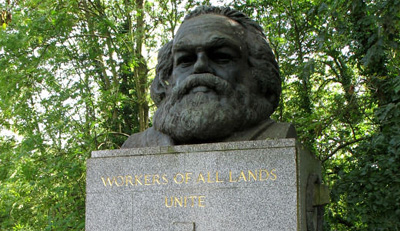
1. Although Americans have long been taught that they live in a two party “middle class society” the first labor parties in the world were founded in
a. Paris and Berlin in the 1840s;
b. London and Dublin in the 1850s;
c. New York and Philadelphia in the 1830s;
d. Moscow and Warsaw in the 1860s.
2. As the industrial labor movement developed in the later 19th century, conditions in the U.S. were different than in many European countries because
a. American corporations accepted trade unions and collective bargaining;
b. American workers wanted to be capitalists and had no interest in unions;
c. The high standard of living workers enjoyed made unions unnecessary;
d. Capitalists could and did use racism, sexism, ethnic divisions, industrial espionage, private detective agencies, and military and police forces to subvert unions and break strikes.
3. During the great labor upsurge of the 1930s and 1940s, the working class in the United States won its greatest victories in terms of national legislation and policy. Which one of these major pieces of legislation in the period was not a victory for labor
a. The Fair Labor Standards Act;
b. The National Labor Relations Act;
c. The Taft Hartley Act;
d. The Norris-Laguardia Act.
4. Communist trade unionists were different than many others in the trade union movement because
a. They sought to broaden the union’s involvement in both larger political issues and community struggles;
b. They saw trade unions as stepping stones for the empowerment of the working class, not simply agents to increase the wages and benefits of specific groups of workers;
c. They had the establishment of a socialist society as their long-term goal, which animated their daily activities;
d. All of the above.
5. The long-term effects of the purges of Communist trade unionists and their allies after World War II, defined as the “defense of democracy” against “totalitarianism” can be seen in
a. The huge increase in the real wages of American workers , especially from 1980 to 2014 following the increase of the stock market’s Down Jones Average increased more than ten times;
b. The sharp increase of both income and assets equality for the American people especially since 1980, showing the triumph of “middle class democracy” in America;
c. The establishment of universal health care, paid parental leave, paid four week annual vacations, family allowances, all as essential rights for all Americans, giving the U.S. a welfare state as advanced as any in Europe;
d. The decline in the number of unionized private sector workers from around 35% before the purges to less than 10% today, along with the loss of millions of jobs, and the increase in income and assets inequality for the American people, along with the evisceration of the pre 1980 social safety net.
Click for answers.


 Join Now
Join Now